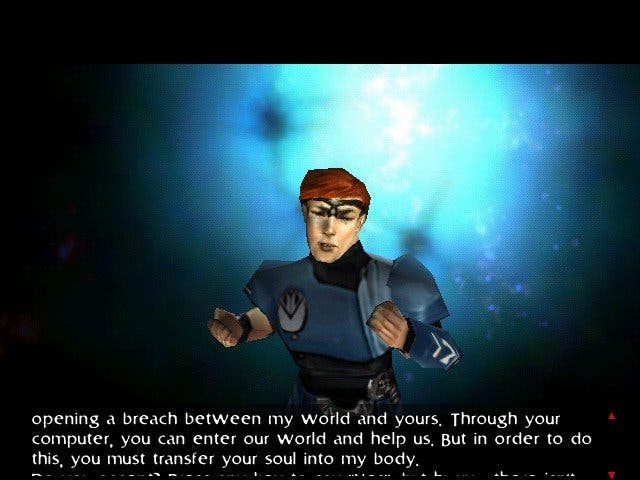Retrospective: Omikron: The Nomad Soul
One for the dreamers.
David Cage is a man of extraordinary vision. Whether you believe his games match his ambition is a very personal thing. I will argue with you that Fahrenheit is one of the most exciting games I've ever played, even though it's broken in about 657 ways. Perhaps this is what's most exciting about Quantic Dream's output. However, I cannot find a similar love for Omikron: The Nomad Soul. And that's not because I can't run it on my PC.
It appears that the more recent ATI cards have seen fit to stop supporting Z-buffering, or something similar. I'm not Richard Leadbetter I'm afraid, so these words sound like buzzing to me, but what I know is it means The Nomad Soul paints the screen in giant black squares with every movement. For a game that's based around a combination of adventuring, first-person combat, third-person fighting and spotting teeny tiny objects on the floor, a mostly black screen isn't ideal (Richard would agree, I'm sure). Which put me in something of a pickle, if it weren't for the nagging certainty that I owned another copy. For Dreamcast.
Cancelled on both PlayStation and PS2, The Nomad Soul came out for PC and Dreamcast. Of all systems. It's set in the city of Omikron (we'll get to the game name confusion in a bit) on the planet Phaenon. But you're not playing a citizen of that world - you're playing you, playing a videogame. By beginning the game you've agreed to have your soul transferred into the body of a citizen of Omikron, and thus control him as an avatar. It's an opening moment of Brechtian estrangement that ensures you're aware that this isn't going to follow conventions so much as dissemble them. Your body previously belonged to a police officer who was investigating a series of murders. So it's from there you pick up.

I'm impressed my Dreamcast still works. It's not been switched on in three years at the very least. An Xbox would surely have turned doorstop by now. A PSX burned through a dozen chips. But the Dreamcast must have been built like a 1950s refrigerator. The gasping and wheezing as it spins the disc is like a soundtrack to 2001 and Virtua Tennis 2.
The Dreamcast version of the game, released six months after the PC version, was criticised in 2000 for falling short of the PC build. Weaker graphics, long load times, weird bubbly voices in places, and most of all, no dialogue changes to reflect the platform, leaving players instructed they were playing on a computer, staring at a monitor. But take that, PC! You can't play it any more. The DC, like the brave tortoise, has won the race.
Except all those things are horribly true. It looks phenomenally awful, a smear of brown and grey filled with polygonal characters that belong in the mid-nineties. Walking through a door takes an extraordinary amount of time, needing to load in two separate chunks each time you want to walk out of a shop entrance, staggering and croaking throughout. And oh dear me, when you're attempting to break the fourth wall it's a good idea to make sure you're referring to the circumstances the player is actually in. I'm holding a controller in front of my TV, Omikron. Not sat in front of my monitor. I think you might have the wrong soul.
But such ideas! This notion of being you trapped in a character's body is a really nice one, somewhat literalising the way we understand our role in gaming. But it's taken a step further. You're not just a character, you're a character in a game. It says so. Talking with one character you're given the conversation option, "What does it matter if I die? It's only a videogame." In fact, you're told, Omikron is a game created by demons in order to capture our souls. Which brings us to the name.



